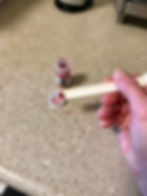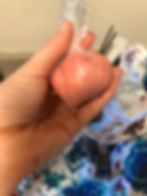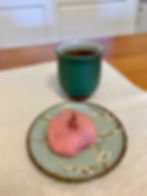Much Ado About Mochi (ASIAN 258)
- Erin Brightwell
- Mar 2, 2021
- 7 min read
Updated: Mar 2, 2021
お久しぶり 。When Professor Brown heard that I was going to make sakura mochi (Sakura Rice Cakes) for Girls’ Day on March 3, she asked me if I’d be up for giving you all an entry on this traditional Japanese spring treat. Mochi, of course, have already made it into the US mainstream in some form, but today I’ll walk you through a couple of options that are more old school than, say, Trader Joe’s mochi ice cream.
Mochi, as you already probably know, have a long history in Japan. Historian Eric Rath cites an example of mochi as early as the eighth century (!) and points out their ongoing ritual significance to this day.[1] In fact, on May 1, 2019, ceremonial mochi were made at Ōsaka Tenmangū—one of Japan’s major shrines—and distributed to people who had come to commemorate Emperor Akihito’s abdication and the beginning of a new reign period. These were mochi in no-frills form: steamed and beaten glutinous rice rolled into cakes and dusted with kinako (roasted soybean flour). Although the rice must have been hulled first, what you can see below is that it was steamed prior to being pounded with enormous wooden mallets. You can also see that the receptacle for the rice pounding is hung with a shimenawa to ensure its purity.


There were numerous opportunities to pound the dough, since we had a lot of mochi to make.


Once the steamed pounded rice was deemed ready, it was quickly transported to a table, where we tore off pieces and rolled them into serving-sized portions. We had to work quickly, because the mochi get hard just sitting around. These mochi were then, as mentioned, dusted with kinako and handed out to shrine visitors to be eaten on the spot.

(Photo by Carmen Tamas)
The two types I’ll take you through today, however, are both newer versions that have sweet red bean paste, anko, in the middle: ichigo daifuku (Strawberry Good Luck) cakes and the aforementioned sakura mochi. Although the combination of anko and rice cakes is not itself new—Rath says it may go back as far as the seventh century—the very sweet aspect to anko is: Rath credits it to the arrival of sugar brought from China by the Portuguese.[2]
If you haven’t decided which mochi you want, you can start with the bean paste, since both versions require it. It’s easy to find online, but if you want to make your own, it’s a little time-consuming, but simple. I used this recipe. I appreciate that the author has both a more traditional version and an easier version. As someone who has eaten a fair amount of anko-based sweets (albeit mostly from convenience stores), I thought this easy version was just fine. A couple of practical notes—the recipe splits into 2 paths like a choose-your-own-adventure about halfway through. You need to follow the first steps, 1-8, and then choose “koshian,” which means ignoring the “Tsuban” steps and scrolling down to the “Koshian” option. If you’re going the home-made route, you should be making your anko the day before you plan to make your mochi.
Back to the beginning. The recipe works as is. I didn’t have an otoshibuta, but my beans were fairly sedentary on low-medium heat. This didn’t seem to be an issue. I also found that my beans were definitely not ready after an hour. Even after an hour and 30 minutes I still wasn’t sure. So I simmered them for 10 more minutes while de-icing the patio. Perfect.

Now, down to the Koshian option. I recommend keeping all of your liquid after straining the beans. I needed way more than the 1-2 Tbsp. the recipe calls for, probably more like 4-5 (at least). If your beans are too dry for your blender or food processor to handle, add some of the bean water you kept. Regular water also works fine. Add a little at a time until your blender can handle it.

If your beans are a really thick paste despite your water (as mine were), simply add a little more water when you put everything back in the pot. After all, you need liquid to dissolve the sugar and salt. It should look like a really thick soup. If you inadvertently go a little overboard with the water, don’t worry. You only need to cook your anko longer. It will turn out fine. I ended up stirring over low heat for about 30 minutes until I could draw a line that didn’t immediately fill back in. Once I hit that magic thickness, I put it in the cookie sheet and let it cool. In the future, I might cook it a bit longer, since this was still pretty soft (but shapeable) even after cooling.


At this point, after your paste has cooled, you need to make up your mind. Strawberry mochi will require 6 balls of anko at 25 grams each. Sakura mochi will require 6 balls at 20 grams each. The rest can be frozen in an airtight container for two months or so.
PLAN A: 🍓 Strawberry
The origins of this variation are unclear. As you’ll see, the recipe site dates the dish to the 1980s. However, Eric Rath mentions a strawberry-filled mochi already in 1733.[3] In any case, whenever they first appeared on the scene, ichigo daifuku are delicious. For today’s posting, I used this recipe. It mostly works as is, but I have some pointers for those of us who don’t have microwaves… I made the anko balls the night before. The day of, I started with the strawberries. The recipe author is not kidding around when she recommends smaller. These were the smallest Kroger strawberries, and they were borderline too big.

As you can see, my assistant was distressed (needlessly) about my ability to work with such enormous strawberries.

If you’re steaming the rice, be warned: 10-12 minutes is not enough. I ended up steaming for 25 minutes total, mixing the dough every few minutes. If, like I, you’re not sure what “translucent” mochi dough looks like, it should basically look wet and shiny. I tried to get a picture that reflected that a little better. When it’s done, you can just dump it onto a corn flour-dusted surface and get to work. NOTE: if your mochi dough is sticky despite said corn flour, that means it isn’t ready. Just put it back in the steamer for longer. No harm done.


The mochi assembly is pretty much as the recipe describes. I tried to stretch my dough as thin as possible to accommodate my gigantic berries. Unlike pie dough, you can be thinner at the edges, since it’s all going to get bunched together at the bottom. Being careful not to tear the dough, gently wrap it around the berry, pinch together the bottom, and you’re done!


Perfect for spring or summer.

PLAN B: 🌸 Sakura
Once again, the origins of this variation are murky. However, several people—including the author of today’s recipe—list a special kind of flour, Dōmyōji-flour, as key to the Kansai-style version of the dish. According to the temple Dōmyōji’s website, this flour is made from the type of rice offered daily by the aunt of the ninth-century courtier and scholar of Chinese learning, Sugawara no Michizane (845-903), after he was exiled to what is now modern-day Kyushu. Believed to have healing powers, demand for the rice grew, and the process for making this flour was born. Michizane himself died in exile and was later deified as Tenjin in order to placate his wrathful spirit. One of the major shrines to Tenjin, in fact, is the shrine where we made mochi for the imperial abdication noted above!
For Sakura mochi, I used this recipe. The night before, I rolled my bean balls, rinsed my rice 5-6 times, and put it aside to soak in a place where my assistant couldn’t get to it. As for the rest, you can pretty much follow the recipe as is, but I do have a few additional pointers/clarifications.

1) The day of mochi making, I first put the pickled flowers (available online) in room-temperature water and left them to soak for 30 min. They were still pretty salty even then, so a slightly longer soak would probably not do any harm. Let them dry on a paper towel when done.

2) Then I drained the rice and gave it several (10?) “pulses” in the food processor on the “chop” setting. The rice should be broken, but not a fine powder. Since we are making Kansai-style, the finished cake will be recognizable as made of rice grains. The rice on the left has been "chopped" but not yet steamed.
3) When that’s done, transfer it to a thin towel and steam it for 30 min. While the rice is steaming, make the pink juice and sugar syrup. My pink juice is courtesy of food coloring. As you can see, a little goes a very very long way.


4) When you make the mochi, wet your counter before you put the saran wrap (aka “cling film”) on it. That will make it stay in place. Then put your rice in the center. I recommend flattening it with a plastic paddle—lightly wet the paddle each time between mochi, and it will keep the rice from sticking to it. Transfer your bean paste to the center of your flattened rice circle (I used chopsticks to minimize handling) and gently wrap up the entire thing, twisting the saran wrap together. Pickled cherry leaves are impossible to come by during the pandemic, so we’ll skip that (delicious) step. Instead, you can probably just deposit the mochi on a plate at this point, since they are easier to handle when cool, but I found cupcake wrappers worked well.


Then place a flower on top and you’re done! Although these are traditional for Girls’ Day, they are also yummy for blossom viewing parties in the spring. Given how cold out it still is, you’ve got plenty of time to perfect your mochi-making skills before the cherries bloom. Enjoy!

⚠️ All three of the above recipes were first-time attempts for me, so don't be intimidated. In my experience, knowing how things are supposed to look is at least half the battle. Good luck!
